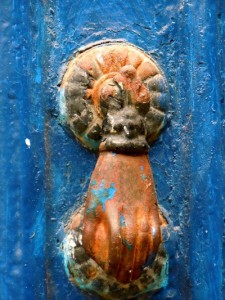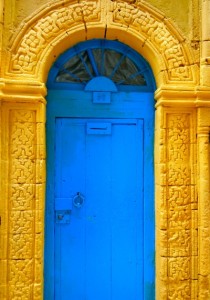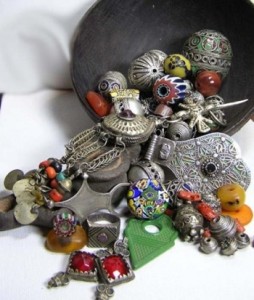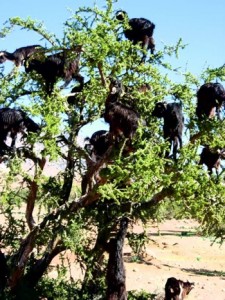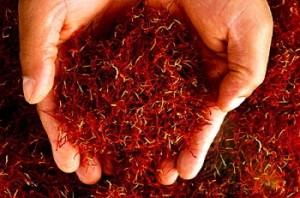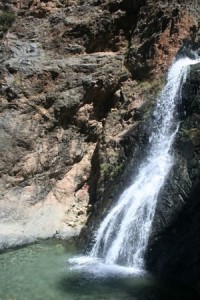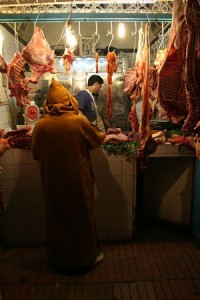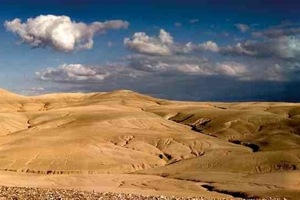Posts Tagged ‘Travel to Morocco’
Moroccan door knockers can be found throughout Morocco and are palm-shaped. Door knockers in Morocco are a symbol of protection for the home as they are typically designed in the shape of the “hand of fatima” (Khamsa, Chamsa or Hamsa) and made of solid brass, cast iron or wood by a skilled artisan. Each door knocker that I’ve seen during my travels in the Magreb’s old cities of Marrakech, Essaouira or Fes have either been oxidized by the artist or they have developed a fabulous, aged green patina. The patinas are typically in various shades of green and are similar to those found on the statue of liberty in the New York harbor and on on ancient buildings in Europe. The green patina that forms on the chamsa Moroccan door knockers is natural and they resist corrosion which accounts for why they have remained on some of Morocco’s most extraordinary doors for centuries.
The magic of Morocco is found in many places and one of them is in the hand painted doors of Essaouira. To travel inside Morocco is to visit this vast country one door at a time. Moroccan doors in Essaouira are ordained with Moorish style motifs, chamsa door knockers and painted in a variety of hues such as in Majorelle blue and canary yellow. Doors in Morocco are a gateway to another world and bare emblem of history along with the secret lives in a Moroccan home. Made of wood, metal and plaster Moroccan doors are a photographers dream as they make for the perfect subject matter.
Morocco’s Treasure Hunting Tour of North African Silver Jewelry & Trade Beads is on the calendar for Spring 2011. Come Travel to Morocco and enjoy fourteen days of sheer jewelry bliss. Save your Morocco tour dates: September 16th – 29th, 2011. Bead your Way Through Morocco is a Moroccan Jewelry & Trade Bead Treasure Hunting Tour created by Travel Exploration Morocco and hosted by Sarah Corbett, a Tribal Jewelry Expert. Travel Exploration Morocco is a New York and Ouarzazate based Travel Agency and the first to offer this customized Moroccan Jewelry & Trade Bead Tour to Morocco with a Tribal Jewelry Expert.
The first time I visited Morocco, I saw postcards that featured goats perched in Argan trees. Sure, I thought, this is a gag. Surely they must have either tied stuffed goats to branches or retouched photos. So the first time I visited Argan Country, near Essaouira and Agadir, boy, was I surprised. There were real goats in the trees! Munching away! I soon found out that was going on. The goats were exclusively found in argan trees. Argan is a relative of the olive, and the goats were eating the argan fruit. Argan is grown exclusively in the southwest region of Morocco. It is difficult to cultivate and as a result, wild trees are treasured. Argan oil is prized in Morocco and recently has been discovered by the West. It has been used for centuries for cooking and cosmetics. The oil is extracted from the kernel of the pits.
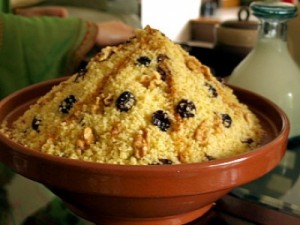
Moroccan food is considered some of the best in the world. The easiest way to discover the true flavors of Moroccan cuisine are to take a Moroccan cooking class or explore various restaurants in Morocco’s Imperial Cities such as Marrakech, Fes, Rabat or Essaouira on a Morocco tour. Another way to discover authentic Moroccan cuisine is to dine with a local family in a Berber Village. Berber villages are known for their unique fare as result that their main staples in making Moroccan traditional cuisine such as couscous are grown locally in their fields alongside special herbs which allows for amazingly tasteful food. Moroccan recipes such as baking bread by fire and a tajine on starlit night can be learning on a Sahara desert tour to the Erg Chebbi Dunes of Merzouga whereby your camel trekking guide takes you off on a journey into the vast dunes to a Sahara camp at sunset to learn the secrets of the Sahara. To fully enjoy a Moroccan meal one must arrive with an empty stomach and then fully prepare themselves for a three or four-course Moroccan feast. As the French proverb says, “Appetite comes with eating; the more one has, the more one would have” so make sure to visit Morocco with an open palate and a big appetite!
Saffron is a deep red spice that comes from the purple Saffron Crocus, or Crocus Sativus, and is found in many Moroccan food recipes, is used as a dye, and is believed to have medicinal benefits. The spice itself comes from the tiny thread stigmas of the flower which are traditionally hand-picked and then sun-dried to bring out the aromatic flavor. It takes 140 flowers to produce just one gram of saffron that accounts for its high market price, in fact, saffron has been said to be worth its weight in gold, literally!
Marrakech located at the foot of the Atlas mountins is one of Morocco’s most popular cities in Morocco. A favorite retreat for royals and visitors, Marrakech has made substantial efforts in recent to turn itself into Morocco’s greenest city. Princess Lalla Meryem, King Mohammed VI’s sister has invested much time and money to upgrade oases and parks. One of the parks that has been renovated to pristine beauty and sits just next to the new, elite Royal Mansour Hotel is Cyber Park.
Morocco’s Ourika Valley is one of the most charming places to visit if you’re looking for a one-day excursion from Marrakech to escape the heat or are in need to go for a long hike. The Ourika Valley is located just an hour outside the heart of Marrakech and boasts lush green gardens, several lakes and the famous Setti Fatma Waterfalls.
Near the vegetable and fruit markets (souks) in Morocco, you will easily spot the meat market; small stalls specializing in particular meats: one for beef, one for lamb, one for poultry; even one for offal, or innards. These are open-air affairs. If you’re squeamish and used to the refrigerated, hormone-filled shrink-wrapped proteins in America, relax! Moroccans and other cultures have been shopping in this manner for centuries with no harm done. Also remember, when you’re cooking meat, poultry or fish, the high heat will effectively burn off any dust from the market.
The Agafay Desert of Morocco sits on outskirts of Marrakech. The Agafay Desert is just an hour’s drive from the bustling souks, the Majorelle Garden, the Koutoubia Mosque and the heart of Marrakech. The Agafay Desert is an undeveloped area and is the perfect one-day excursion from Marrakech if you don’t have time to visit the Merzouga, M’hamid or Zagora Sahara Desert during your Morocco vacation. On a one-day excursion from Marrakech to the Agafay Desert you can also visit Kasbah Tamadot, owned by British mogul Richard Branson and stop to visit the local souks and co-ops within the Ourigane Valley.

